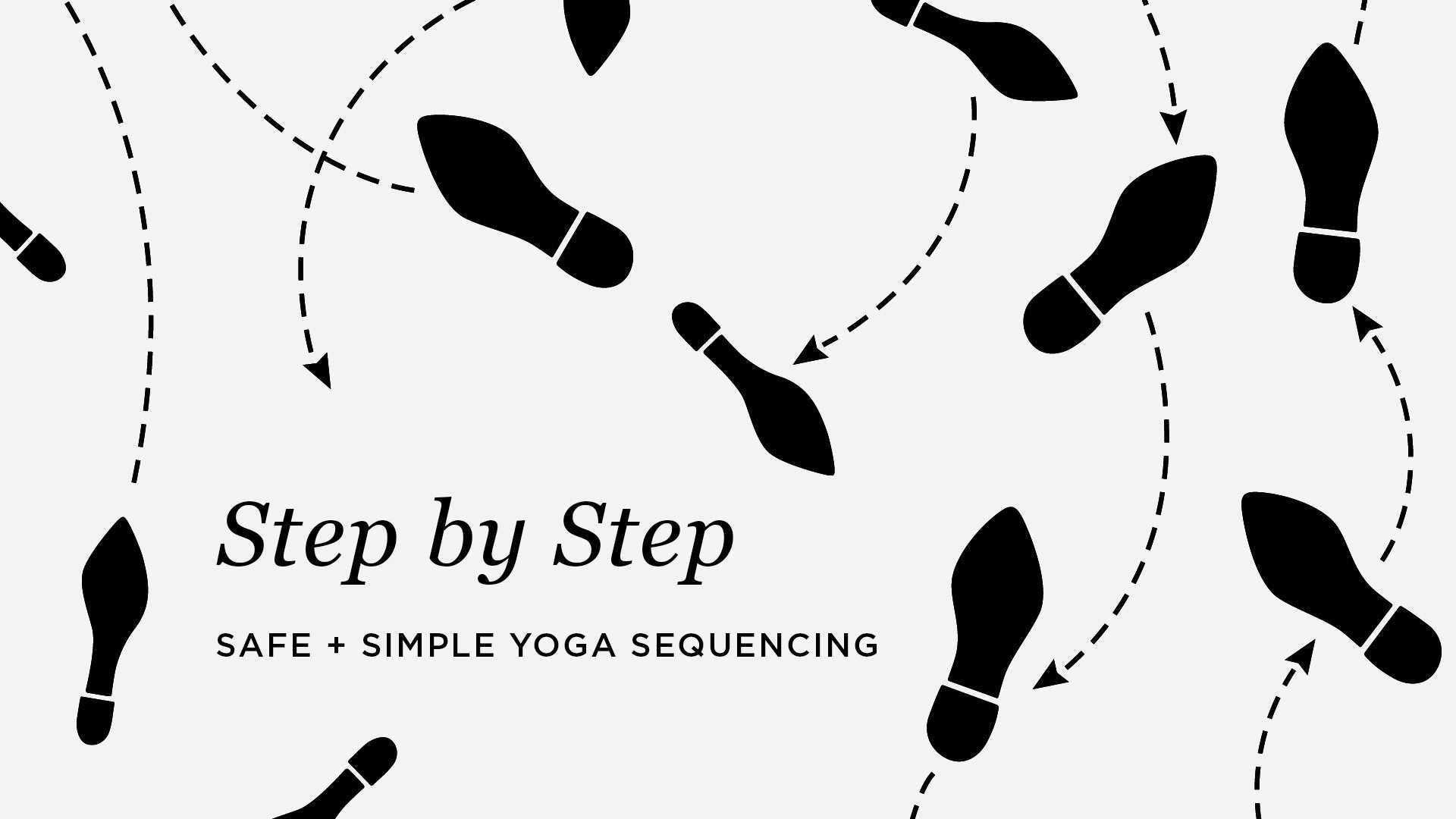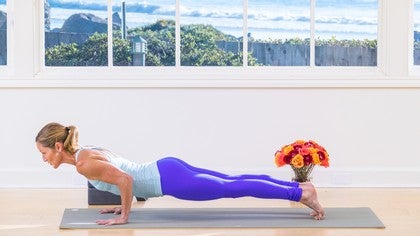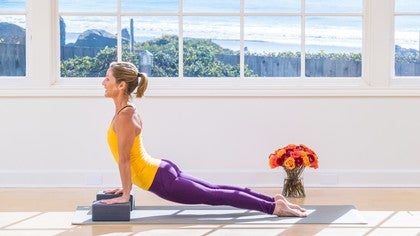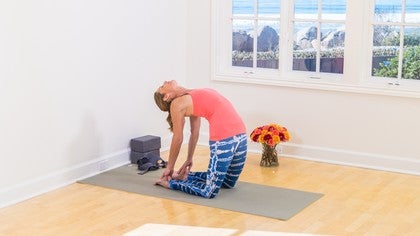Description
About This Video
Transcript
Read Full Transcript
Welcome back. For this session, we're going to start to break down Chaturanga Dandasana. Chaturanga Dandasana means, in Sanskrit, Chatur means four, Anga Lim, Danda, Staff, Pose, Asana, Pose. So four limbs, staff, Pose. Four limbs, staff, strong, line. So we're going to start in our blueprint pose, Tadasana, Mountain Pose. So actually, in Chaturanga, in most of our practices, the feet are apart. So I'm just going to take the feet hip distance apart, right? If you practice Chaturanga with your feet together, you can also do it this way. So feet hip distance apart for stability. I want you to root into your feet. Feel the calves press a little forward, right? So they're starting to turn on, activate a little bit. Outer ankles seal in a bit. Inner ankles lift up, right? So we have this upward and inward draw. So our energy is moving in. From here, we're going to start to lift up through our hips, having the pubic bone find neutral, right? So often, if we lift our hips, we start to sway. We start to come forward and tuck. We don't want to do that. We just want to create a little bit of length, and we want to stay away from creating a sway in the back. So coming right to neutral. Inner thighs draw in a bit, and then there's the play of the balance of inner thighs drawing back to create space, but an equal balance of the outer thighs coming forward. So it's just playing there, finding the torso long, the heart lifting, collarbone spreading. We're going to start with palms facing forward, and then just start to rotate inner upper arms forward, outer arms back. Backside of the shoulders, slide it back. So if you've been doing any of the other classes in this series, you'll see that this is kind of the theme, moving with the shoulders here. We want you to bend the elbows, and then from here, flip the forearms down, palms down, and flex at the wrists. So here you are. You're in Chaturanga right now, standing up. And then come on down to your knees. Before we progress in, some of the benefits of this pose are strengthening, creating stability, creating confidence. We also work on stretching a little bit. So there's a balance of stretch and strength. So some reasons you might not want to play in this pose today, wrist mischief, elbow, shoulders. So if everything is okay, come along and we will get to it. So just take a moment to stack wrists in line with elbows in line with shoulders. Go and find that rotation, inner upper arms forward, outer arms back. We'll micro bend through the elbows just to be kind to the joints. And then find a neutral spine, keeping the natural curvature in your spine, not trying to straighten anything out. So from here, we're just gonna do a little bit of play with the upper back. So I want you to press through the palms and round just the upper back. Feel this sliding in, the scooping of the armpit. So we're activating through the serratus muscles here. Then inhale, just the upper back. See if you can bring the heart forward. So sliding the shoulder blades towards each other and bringing the heart a little forward. So those are your rhomboids starting to activate, bringing the heart forward. Good. Exhale, little press. Inhale. So this translates to the pose. Just keep moving with your breath just a little bit to kind of wake up through that part of your body. This will translate into the pose when we start to move into plank, into chaturanga. Feeling the stability and feeling the balance between the two. We don't want to be so much that our shoulder blades are touching and we need to broaden the back through there and we don't want to be so much that we're rounding and shoulder blades spreading. So we need to compromise. Find a balance. Good. So from here, one foot at a time, come on back into plank pose. So if you're working on building up strength for chaturanga, hang out here. Work on that action of finding balance between the shoulder blades, coming together a little bit and then broadening. Find the rotation of the arms by creating more space, a deeper pocket in the armpits. And then the exhale, come to the knees. Take a moment. So next time we move into plank, we have this focus on the armpits, on the shoulders, on the chest. Now think about the rest of your body. So in the title of the pose, dandasana, staff, it's strong, it's long. So we're going to come back to plank pose. Curl the toes under. Press out through the heels. Again, just as we did in the blueprint, draw the outer ankles in, inner ankles up. Find a little shift forward. Draw the heart slightly forward. Inner thighs rotate up, outer thighs roll down just a bit. And outer thighs actually press up. Didn't mean that.
Torso long. And then for stability, draw the belly button back to the spine just a little bit. Good. Exhale, come down onto the knees. And know if that's too much, you can always work that on your knees. So just to show that real quick. Come down onto the knees and pause. So you can play right there. Reach for your strap and you're gonna create a loop in your strap that's about shoulder distance apart. And for this one, you want it to be where you can press out. So in some of the other backbends that we've done, we've done them a little shy of shoulder. Make this one on the outer edge of shoulder distance. Good. So bringing your strap above the elbow joint, checking that the buckle is not on the skin. Take the tail out to the side, come back to plank pose. Hmm. So you want to press like you're trying to snap this strap, right? And that's gonna give you a little bit more lift. Excellent. So from here, I'm gonna ask that everyone come down onto their knees and you start to shift forward. As you shift forward, you start to bend your elbows, right? And just pause. We're gonna go in increments. Pause. So as we come into this pose, the elbows and the wrists start to line up, the chest comes forward and then press out. Good. Going back in again on an exhale, bend the elbows, bring the chest forward and you'll notice the strap stops you. Roll the shoulder heads back and pause. Inhale, come on up and I'm gonna loosen my strap just a little bit so I can create a little bit more space. So when we start to slide forward, we're gonna shift the body weight forward, elbows come over the wrists, moving from plank or onto the modified here. We're gonna slide forward, come on back down, roll the shoulders up, right? So never in Chaturanga do we want shoulders to go below the elbow. So right here, I'm a little bit higher. I'm working the arms. I want my arms by my side but I don't want them touching my side. Inhale, come on up. Unless you're wider, unless you're a little bit wider through the midsection, then they can touch but you don't want to press and rest. Good. Another set. Come on back down into plank pose. Come on to the knees, modify one more and then slide forward, right? We do that slide forward so the elbows can be over the wrists, chest forward, slide the shoulders back. So the strap starts to pull the shoulders down. See if you can pull them back. Good. Sides of the neck long. And then take the gaze slightly down, maybe a little in front but we're gonna stay away from this. Slowly come back up. Good. Now we're gonna move in from plank to Chaturanga full. So to start, we're gonna actually bring two blocks right underneath the hips. So this will be pretty high. So if you need to and you have a hard time moving from full Chatur full plank pose down, these will be here to catch you. Keep us a little bit higher up. So bring the palms down, curl the toes under, slide forward. So see this shift forward. As I start to bend, taking the sides of my neck long and I pause and they can be on the thighs, pubic bone, hips, right here. So I'm resting but I'm not completely letting my body weight go. Heartless shoulder blades draw back towards each other, right, but they're drawing down and then I'm still spreading, broadening through my back. Good. Come on up. One more time through. I'm gonna slide these up a little bit and we'll try it again. Come on down to the palms. Take the legs back straight. Find that shift forward as you start to lower, bend the elbows, hands are shoulder distance apart and pause. So drawing the pubic bone to find neutral, right. So we don't want to sway, we don't want to tuck. The nice thing is with the strap, it supports you. You could stay here all day. If you need to, use the blocks. Come on back up. So before we move into full pose moving from plank to chaturanga, we can remove this. You can keep the strap if you find that you can't keep your arms in. So this being one of those poses that in a flow class is done over and over again. I believe in the Ashtanga Primary Series it's done some 58 times. Don't quote me. But so that's a lot and it's a lot if we're doing something a little bit out of alignment. So really making sure our foundation is solid before we start moving in. So as we set up, checking risk creases parallel. Middle fingers forward. Good. A nice even spread through the hands, right. But we're not overextending. Start to find the rotation, inner upper arms come forward, outer arms back. And then as you have this rotation, you're gonna slide the forearms back. So I teach eyes the elbows are diagonal, right. You might have some teachers that force more the eyes the elbows towards each other which might be more action in the forearms. From here curl the toes under. Hips. So draw in, right. So there's a long line of energy coming out through the crown, long line of grounding energy out through the heel. And as you shift forward, you're gonna start to dip. Dip just through the arms, heart comes forward. So there's a broadening through the back, right. Enjoying that shake, don't let the shoulders come below the elbows. Exhale on the knees, press on back. So why the emphasis on not letting the shoulders dip below the elbows? One, as soon as we dip below that point, we get much weaker. And two, as soon as we do that, we start to create impingement in our shoulders and guaranteed over a number of years it will lead to shoulder injury. We have a lot going on in our shoulder capsule. So yes, when we start to dip down, lots gets impinged, pinched, not enough space. So let's come back in. Plank pose. Take the time to set up, risk creases parallel, equal distance from the edges of the mat and shoulder distance apart. Curl the toes under, right. Find a solid plank pose. So option here, we're knees down. Find a shift forward. Gaze down with a tilt a little forward and then slowly lower, right. It might be here, it might be here. And take the time to look on my shoulders above my elbows. A few more breaths, a little shaking. Exhale onto the knees. Press on up. So in just reviewing, the body from basically the mid ribs down is like tadasana. It's our blueprint. It's strong. It's a dandasana. It's a staff, right. So it's long, strong. And then from the shoulders, we're working the rotation and setting the shoulder blades down the back, feeling that nice wrapping and broadening of the back. So the shoulder blades start to spread a bit at the bottoms, but there's still this energy of drawing in towards each other to press the heart forward. So some of the things I see often that I believe lead to injury is speeding through this. It's like that whole mix of plank, chaturanga, upward facing dog, it gets like one breath. So if we can slow it down, we can decrease our chance of injury, right. So I bring into my practice and into my teaching a sacred pause. Even if we're moving one breath per movement, it can be exhale, chaturanga, pause, inhale, upward facing dog. So take the time to hold, to settle, and then move through your next pose. Great. Well, I hope you picked up a nugget or two. Thank you for joining me.
Namaste.
Step By Step
Comments
You need to be a subscriber to post a comment.
Please Log In or Create an Account to start your free trial.










